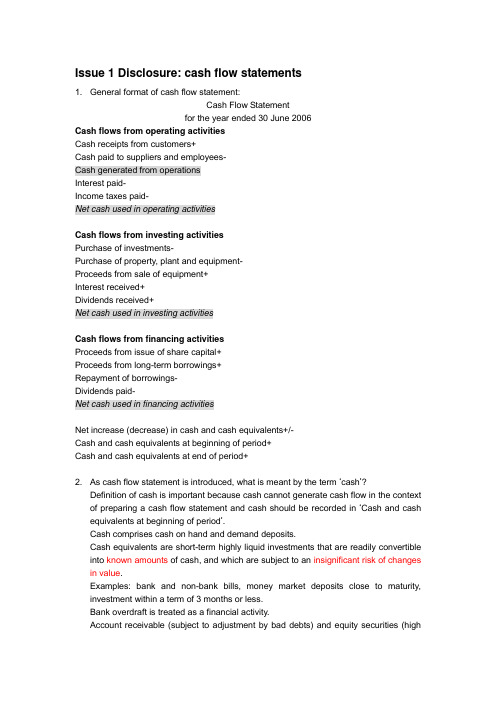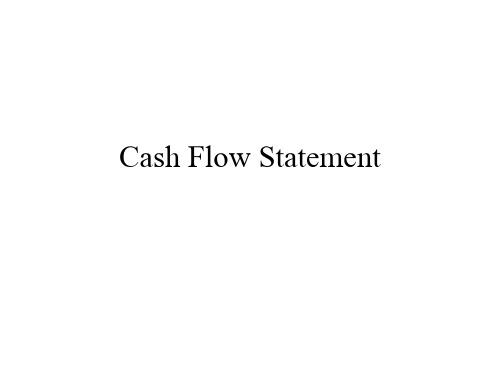Cash Flow Statement
- 格式:ppt
- 大小:515.50 KB
- 文档页数:43

什么是现金流量表现金流量表的编制方法有哪些现金流量表(Cash Flow Statement)是会计报表中的一项重要内容,用于反映企业在一定会计期间内的现金流动情况。
它以现金为核心,记录了企业经营、投资和筹资活动对现金流量的影响,为用户提供了判断企业现金流量状况的依据。
现金流量表的编制方法主要包括直接法、间接法和调整间接法。
一、直接法编制现金流量表直接法是按照现金支付和收入的性质进行分类,逐一列示各项现金收入和支付项目的金额,然后计算各项现金流量的总和,以得出净现金流量。
直接法编制现金流量表的步骤如下:1. 经营活动的现金流量- 销售商品、提供劳务收到的现金- 支付给职工以及为职工支付的现金- 购买商品、接收劳务支付的现金- 支付的各项税费- 支付的其他与经营活动有关的现金2. 投资活动的现金流量- 收回长期债权投资收到的现金- 取得投资收益收到的现金- 处置固定资产、无形资产和其他长期资产收回的现金- 购建固定资产、无形资产和其他长期资产支付的现金- 投资支付的现金3. 筹资活动的现金流量- 吸收投资者投资收到的现金- 取得借款收到的现金- 偿还借款支付的现金- 分配利润支付的现金- 以及筹资支付的其他现金4. 现金流量表编制将以上三个活动的现金流量汇总,计算净现金流量,并通过将期初现金余额与净现金流量相加,得出期末现金余额。
二、间接法编制现金流量表间接法是以净利润为基础,通过调整净利润来计算现金流量。
具体步骤如下:1. 调整净利润首先,调整净利润,将其中与现金无关的项目排除,如计提的折旧、摊销、减值准备等。
2. 调整经营活动现金流量根据调整后的净利润,对与经营活动有关的项目进行调整,如变动资金、长短期应收款的变动、应收利息、应付款项等。
3. 调整投资和筹资活动现金流量根据调整后的经营活动现金流量,对与投资和筹资活动有关的项目进行调整,如购建固定资产、支付利息和股息等。
4. 现金流量表编制将调整后的经营、投资和筹资活动的现金流量汇总,计算净现金流量,并通过将期初现金余额与净现金流量相加,得出期末现金余额。

Issue 1 Disclosure: cash flow statements1. General format of cash flow statement:Cash Flow Statementfor the year ended 30 June 2006Cash flows from operating activitiesCash receipts from customers+Cash paid to suppliers and employees-Cash generated from operationsInterest paid-Income taxes paid-Net cash used in operating activitiesCash flows from investing activitiesPurchase of investments-Purchase of property, plant and equipment-Proceeds from sale of equipment+Interest received+Dividends received+Net cash used in investing activitiesCash flows from financing activitiesProceeds from issue of share capital+Proceeds from long-term borrowings+Repayment of borrowings-Dividends paid-Net cash used in financing activitiesNet increase (decrease) in cash and cash equivalents+/-Cash and cash equivalents at beginning of period+Cash and cash equivalents at end of period+2. As cash flow statement is introduced, what is meant by the term ‘cash’?Definition of cash is important because cash cannot generate cash flow in the context of preparing a cash flow statement and cash should be recorded in ‘Cash and cash equivalents at beginning of period’.Cash comprises cash on hand and demand deposits.Cash equivalents are short-term highly liquid investments that are readily convertible into known amounts of cash, and which are subject to an insignificant risk of changes in value.Examples: bank and non-bank bills, money market deposits close to maturity, investment within a term of 3 months or less.Bank overdraft is treated as a financial activity.Account receivable (subject to adjustment by bad debts) and equity securities (highrisk in changes in value) are excluded from the definition of cash.(Note: you need to make clear whether the payment or receipt is for our own company or third parties)4. Preparing the cash flow statementStep 1: Cash flows from operating activitiesThere are 2 methods which can be used – direct method and indirect methodDirect method is based on individual item in income statement. Major classes of revenues are shown as gross cash inflows from operations, and expenses are shown as gross cash outflows from operations. The information necessary to determine the operating cash flows is obtained by adjusting sales, cost of sales and other items in the accrual-basis IS for non-cash items and items not related to operating activities.Under direct method, each item is adjusted from accrual basis to cash basis. Certain items, such as depreciation and amortisation of non-current assets and gains/losses on non-current assets disposed of, are excluded, because they have no effect on cash flow. Indirect method is based on after-tax profit in income statement. The accrual-basis profit is adjustedto a cash-basis profit by making adjustments for non-cash items used in the determination of profit. Added back to profit are the effects of all deferrals of cash inflows (deferred income) and outflows (prepayment), and deducted are all accruals of expected future cash inflows (accrued income) and outflows (accrued expense). The deferrals and accruals of future cash flows are reflected in the changes in the balance of assets and liabilities relating to operating activities. (This method is similar to what is done in preparing tax).Both methods are permitted under IAS7.Bad debts written off is actually A/R written off in UK (Dr Provision for doubtfuldebts/Cr AR)The point is the balance of the allowance for doubtful debts account must not be netted off against the accounts receivable balance. We must use bad debts written off.B. Cash paid to suppliers and employees (and other expenses)For cash paid to employees and other services:Step 2: Cash flows from investing activitiesA. Acquisition and disposal of non-current assetsThis step involves an examination of any changes in these long-term assets in the light of relevant transaction data to determine the effects on cash flows. Hence, you must search the data to check whether the company purchase long-term assets on cash or on credit and sell long-term assets on cash or on credit.Step 3: Cash flows from financing activitiesThe initial step is to analyse the balance sheet and statement of changes in equity for changes in non-current liabilities and equity items. These changes are then assessed in light of additional relevant transaction data to determine changes which resulted in cash flows.Step 4: Ascertain net cash and cash equivalent increase/decreaseStep 5: Reconcile cash and cash equivalent at end with that at the beginningStep 6: Note to disclose the components of cash and cash equivalentsStep 7: Note to reconcile the net cash used in operating activities with profit in the IS by using indirect method.The reconciliation process commences with the accrual-basis profit and adjusting for any non-operating items (e.g. gains/losses on sale of PPE) and all non-cash expenses and revenues.Profit for the periodSubtract: Gains on sale of non-current assets (Profit from investing activities/gains do not affect cash, only sales proceeds affect cash)Subtract: Investment income (Interest and dividends received from investing activities)Add: Depreciation and other write-downs (No reduction of cash)Add/subtract: Changes in current assets and liabilities in BS (Non-current assets and liabilities relate to investment or financing)Step 8: Notes to discuss non-cash financing and investing activities, including acquisition or sale of a subsidiary and of property, plant and equipmentWhy? Since the cash flow statement reports only the effects of transactions on cash and cash equivalents, some material financing and investing activities may be omitted from the statement if such transactions do not affect cash flows.Examples include conversion of long-term debt to equity, the acquisition of other entities by means of a share issue, the acquisition of non-current assets by means of mortgage, and the acquisition of assets by entering into a finance lease.My own thought:The essence of cash flow statement is to turn the accrual-accounting profit to cash-accounting profit (which is also net cash). In order to achieve this goal, there are 2 ways we can choose. The first way is to adjust the accrual-accounting profit, which is called indirect method. Under indirect method, accrual-accounting profit is adjusted by reducing non-cash expenses such as depreciation expense (which means adding it to profit), and gain/loss which does not affect the cash level. Then, we need to adjust the change of current assets and liabilities, which are related to operating activities. Actually, we can subdivide the profit, and this will lead to another method – direct method. Under the direct method, the amount of cash inflow and outflow will be calculated. We can use sales, purchases and other expense together with the change of assets and liabilities to get the cash. Cash generated from operating activities is closely related to current assets and current liabilities; cash generated from investing activities is closely related to non-current assets; cash generated from financing activities is closely related to non-current liabilities and equity.Example:Direct method:Cash outflow = Beginning A/C Payable + Purchases – Closing A/C PayableIndirect method:Net cash = Profit + Increase of A/C Payable= (Revenue –OS –Purchases + CS …) + Ending A/C Payable –Opening A/C Payable= … - (Purchases + Opening A/C Payable – Ending A/C Payable= … - the amount of cash outflow for purchasesDirect method:Cash inflow = Beginning A/C Receivable + Credit Sales – Ending A/C ReceivableIndirect method:Net cash = Profit – Increase A/C Receivable= (Revenue - …) – (Ending A/C Receivable – Beginning A/C Receivable)= Revenue… + Beginning A/C Receivable – Ending A/C Receivable= The amount of cash inflow for sales5. Limitations of the cash flow statement→Past cash flows reported: the statement is useful to the extent that the past cash flow information helps in predicting the future cash flow position. Heavy reliance on the cash flow statement for any one period can be dangerous.→Non-cash transactions and events, such as debt-equity swaps, non-current asset purchases by long-term debt, the use of financial leases, and barter transactions donot appear in the statement but are appendages by way of note. Hence, in evaluating an entity’s future cash flows, careful attention must be given to information contained in the notes to the statement.→Liquidity/solvency: The entity is solvent when the assets (rather than cash) of the entity, when realised, are sufficient to pay off all debts as they fall due.→Management manipulation: management may wish to make cash flows appear better or worse than they actually were during a reporting period. Ways in which cash flows may be manipulated include prepayment, delaying cash payments, postponing acquisition of large investments, deferring debenture issues, use of barter, and the use of finance leasing.→Cost: most entities opt for the indirect method because it is less costly to implement than the direct method.。


四大财务报表中英文对照全文共四篇示例,供读者参考第一篇示例:四大财务报表是每家公司每年都要制作的重要财务文件,它们记录着公司在一定期间内的财务业绩和资产负债状况。
这四大财务报表分别是资产负债表(Balance Sheet)、损益表(Income Statement)、现金流量表(Cash Flow Statement)和股东权益变动表(Statement of Changes in Equity)。
下面将为您详细介绍这四大财务报表的中英文对照。
一、资产负债表(Balance Sheet)资产负债表是衡量公司财务状况的重要指标,它展示了公司在特定日期的资产、负债和所有者权益的情况。
资产负债表的中英文对照如下:中文:资产负债表英文:Balance Sheet资产(Assets):1. 流动资产(Current Assets)2. 非流动资产(Non-current Assets)负债和所有者权益(Liabilities and Equity):1. 流动负债(Current Liabilities)2. 非流动负债(Non-current Liabilities)3. 所有者权益(Equity)资产负债表将公司的资产按照流动性和长期性分类,并将公司的负债和所有者权益细分为流动负债、非流动负债和所有者权益,以展示公司的资产负债结构。
二、损益表(Income Statement)损益表是公司在一定期间内的收入、成本和利润情况的总结,展示了公司的盈利能力。
损益表的中英文对照如下:中文:损益表英文:Income Statement收入(Revenue):1. 销售收入(Sales Revenue)2. 其他收入(Other Revenue)成本(Expenses):1. 销售成本(Cost of Goods Sold)2. 营业费用(Operating Expenses)3. 税前利润(Profit Before Tax)利润(Profit):1. 税后利润(Net Profit)损益表记录了公司在一段时间内的总收入、总成本和净利润,帮助投资者和管理层了解公司的盈利能力。


现金流量表最简单的公式现金流量表(cashflowstatement)是一种重要的会计报表,它反映了一个企业或组织在一定时期内的现金流动情况。
它反映出一个组织的财务资金的收支情况,以及其经营业务的实时状况。
虽然会计报表具有多种形式,但现金流量表通过其最简单的公式,可以清楚地反映出一个组织的资金状况。
现金流量表最简单的公式:“结存金额=期初现金余额+现金流入-现金流出”,即可表示一个组织或个人间的现金流动情况。
其中,期初现金余额可以根据上一期的结存金额计算出来,而现金流入和现金流出是现金流量表的两大组成部分,它们的总和就是结存金额。
现金流入是指企业或组织在一定时期内会收到的现金。
它主要来源于销售收入、投资收入和借款收入等。
现金流出是指企业或组织在一定时期内会支出的现金。
它主要包括销售成本、研发成本、利息支出等。
通过准确的统计和计算,企业或组织就可以计算出一个精确的结存金额。
除了最简单的“结存金额=期初现金余额+现金流入 -金流出”的公式外,会计报表中的其他现金流量表公式,也是比较常见的。
其中,应收现金=期初应收现金+应收现金增加减少额-期末应收现金;应付现金=期初应付现金+应付现金增加减少额-期末应付现金;存货现金=期初存货现金+存货现金增加减少额-期末存货现金;及时准确的统计和计算会反映出企业或组织的现金流动情况,为管理者提供客观、准确的信息,使管理者对现金流量的变动有全面、直接的知情权,从而制定合理的管理方案。
现金流量表的作用在于反映一个企业或组织的财务状况,尤其是企业的短期财务性质。
它可以把一个企业或组织的一段时期内的现金流动情况一目了然。
管理者可以通过现金流量表,及时了解到经营状况,根据已有的现金流量情况,预判未来的经营状况,制定正确的经营方案。
此外,现金流量表还可以用来评估投资者的风险。
投资者可以通过现金流量表,看出企业运营是否充分和有效,以及企业是否有足够的现金流来偿还债务。
这对投资者来说,非常重要,因为它可以帮助他们降低投资风险,在投资的时候做出更好的决策。
英文会计现金流量表
英文中,会计现金流量表通常被称为"Cash Flow Statement"。
这张表用于展示一个特定时间段内企业的现金流入和流出情况,以及这些现金流动的来源和去向。
通常被分为三个部分:
1.经营活动现金流量(Operating Activities): 描述与企业日常经营相关的现金流动,比如销售产品或服务所产生的现金流入,支付供应商、员工以及其他日常开支所导致的现金流出。
2.投资活动现金流量(Investing Activities): 包括企业用于购买资产、投资或收回投资所产生的现金流动。
这包括购买或出售资产(如房地产、设备等)以及投资其他公司等活动。
3.筹资活动现金流量(Financing Activities): 描述企业为筹集资金或偿还债务而进行的现金流动。
比如发行股票、债券,或者支付股利和偿还借款等。
这份现金流量表能够帮助分析人员和投资者了解公司的现金状况,评估其偿付能力和财务稳定性。
如何判断企业现金流量是否正常引言作为投资者或企业管理者,了解和判断企业的现金流量是否正常是至关重要的。
现金流量是企业健康和盈利能力的重要指标之一,对于投资者来说,它能帮助评估企业的价值和潜在风险。
本文将介绍几种判断企业现金流量是否正常的方法和指标。
研究目标判断企业现金流量是否正常的目标是确定企业是否能够持续经营和偿还债务。
以下是一些常用的指标和方法。
1. 现金流量表(Cash Flow Statement)现金流量表是判断企业现金流量是否正常的重要工具。
它记录了企业在一定时间范围内的现金流入和流出情况,可以帮助我们分析现金流量的来源和用途。
•研究经营活动现金流量:经营活动现金流量是企业日常经营活动所产生的现金流入和流出。
通常来说,一个企业健康和正常的经营活动应该有稳定和正面的现金流入,例如销售产品和服务所带来的收入。
•检查投资活动现金流量:投资活动现金流量是企业投资和资产减值所产生的现金流入和流出。
一个企业在业务发展过程中可能需要进行投资,但必须注意控制投资活动现金流出的规模,以保持良好的现金流量。
•分析融资活动现金流量:融资活动现金流量是企业通过债务和股东权益改变所产生的现金流入和流出。
合理的融资活动可以帮助企业筹集资金,但过多的负债可能对企业的现金流量产生负面影响。
2. 现金比率(Cash Ratio)现金比率是一种衡量企业现金流量是否正常的指标,它表示企业可用现金和现金等价物与短期负债之间的比例。
较高的现金比率通常表示企业的现金流量较为正常和稳定。
•计算现金比率:现金比率可以通过以下公式来计算:现金比率 = (现金 + 现金等价物) / 短期负债3. 经营性现金流入比例(Operating Cash Flow Ratio)经营性现金流入比例是另一种判断企业现金流量是否正常的指标,它表示企业经营活动所产生的现金流入与净销售收入之间的比例。
较高的经营性现金流入比例通常表示企业的经营活动健康和现金流量正常。
现金流量表英文术语的名称现金流量表的英文术语包括:
1. Cash Flow Statement,现金流量表的正式英文名称。
2. Operating Activities,经营活动,指现金流量表中涉及公司日常经营活动产生的现金流量。
3. Investing Activities,投资活动,指现金流量表中涉及公司投资产生的现金流量,例如购买固定资产或投资证券等。
4. Financing Activities,筹资活动,指现金流量表中涉及公司融资活动产生的现金流量,例如发行债券、偿还债务或支付股利等。
5. Net Cash Flow,净现金流量,指特定时期内现金流入和现金流出的差额。
6. Cash and Cash Equivalents,现金及现金等价物,指公司可随时用于支付的现金资产。
7. Free Cash Flow,自由现金流,指公司可用于投资、扩张或分配股利的净现金流量。
8. Cash Flow from Operations,经营活动产生的现金流量,是现金流量表中的一个重要部分,反映了公司经营活动的现金收支情况。
以上是现金流量表中常见的英文术语名称,这些术语在财务报表中起着重要的作用,帮助人们了解公司的现金流动情况。
Cash flows from operating activitiesNet income after distributions1,394.01,366.0 Depreciation and amortization838.0896.0 Acquired identifiable amortizable intangible assets, net of accum. amort.0.00.0 Amortization of definite-lived intangible assets88.082.0 Restructuring52.0222.0 Goodwill impairment0.00.0 Stock-based compensation118.0121.0 Gain on sale0.00.0 Deferred tax(30.0)(134.0) Excess tax benefits(7.0)(11.0) Other, net0.011.0 Income taxes103.0(33.0) Changes in operating operating working capitalChanges in trade accounts receivable(63.0)(371.0) Changes in inventories(609.0)(400.0) Changes in other current assets(98.0)40.0 Changes in accounts payable141.0(443.0) Changes in gift card liabilities0.00.0 Changes in accrued compensation0.00.0 Changes in accrued liabilities279.0(156.0) Net changes in working capital(350.0)(1,330.0) Total cash provided by (used for) operating activities2,206.01,190.0Cash flows from investing activitiesCAPEX [Purchase of property, leasehold improvements & equipment](615.0)(744.0) Proceeds from sale of property, leasehold improvements & equipment(16.0)(267.0) Business acquisitions net of cash acquired [& net of intangibles/other](7.0)0.0 Proceeds from sale of businesses [spin-offs]0.021.0 Proceeds from sale of investments56.0415.0 Change in restricted assets18.0(2.0) Settlement of investment hedges40.012.0 Other(16.0)(4.0) Total cash provided by (used for) investing activities(540.0)(569.0)Cash flows from financing activitiesShort-term borrowings (repayments)0.00.0 Long-term borrowings (repayments)(210.0)(99.0) Proceeds from issuance of common stock and additional paid-in capital138.0179.0 Repurchase of common stock [treasury stock]0.0(1,193.0) Preferred Dividends Payable0.00.0 Distributions(234.0)(237.0) Payments to non-controlling interests0.00.0 Other(42.0)(7.0) Total cash provided by (used for) financing activities(348.0)(1,357.0) Effect of exchange rate on cash10.013.0Total change in cash and cash equivalents1,328.0(723.0)SUPPLEMENTAL DATA:Cash flow before debt paydownActuals Estimates2012A2013E2014E2015E2016E2017E2018E22.0943.1868.2823.1774.5769.2764.9897.0905.2943.7981.71,016.41,050.61,084.70.00.00.00.00.00.00.048.046.545.544.643.744.244.6288.00.00.00.00.00.00.01,207.00.00.00.00.00.00.0120.0120.0120.0120.0120.0120.0120.0(55.0)0.00.00.00.00.00.028.0(30.0)(134.0)28.0(30.0)(134.0)28.00.0(11.0)(11.0)(11.0)(11.0)(11.0)(11.0)25.00.00.00.00.00.00.025.0103.0(33.0)25.0103.0(33.0)25.041.044.244.944.043.1(21.1)(21.3)120.082.1105.4110.9108.7(53.2)(53.8)(24.0)34.520.920.520.1(9.8)(9.9)574.0(380.7)(93.0)(97.8)(95.9)47.047.40.0(5.9)(9.0)(8.8)(8.6) 4.2 4.30.020.9(8.6)(11.0)(10.8) 5.3 5.3(23.0)(91.6)(24.6)(31.4)(30.7)15.115.2688.0(296.5)35.926.325.8(12.6)(12.8)3,293.01,780.41,835.42,037.72,042.41,793.32,043.5(766.0)(749.5)(770.5)(760.0)(693.0)(683.3)(683.3)(112.0)(112.0)(112.0)(112.0)(112.0)(112.0)(112.0)(174.0)0.00.00.00.00.00.00.00.00.00.00.00.00.0290.00.00.00.00.00.00.040.00.00.00.00.00.00.00.00.00.00.00.00.00.0(2.0)0.00.00.00.00.00.0(724.0)(861.5)(882.5)(872.0)(805.0)(795.3)(795.3)0.0(523.0)0.00.00.00.00.0509.0(1,403.4)(281.6)0.00.00.00.067.00.00.00.00.00.00.0(1,500.0)0.00.00.00.00.00.00.00.00.00.00.00.00.0(228.0)(141.5)(130.2)(123.5)(116.2)(115.4)(114.7)(1,303.0)0.00.00.00.00.00.0(23.0)0.00.00.00.00.00.0(2,478.0)(2,067.9)(411.8)(123.5)(116.2)(115.4)(114.7)5.00.00.00.00.00.00.0。